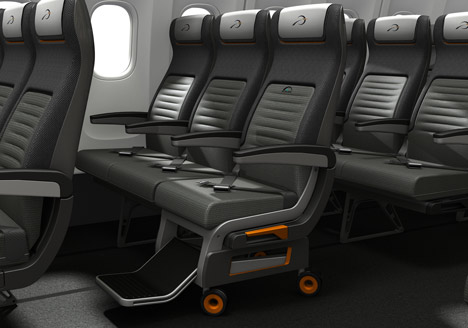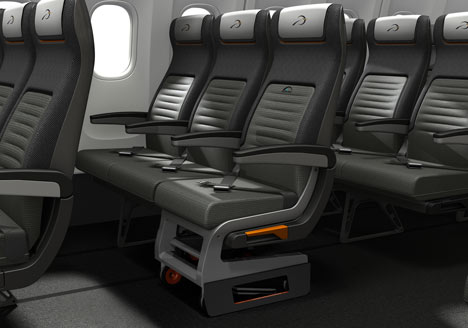Air Access by Priestmangoode
Paralympic athletes headed for London 2012 have inspired transport design studio Priestmangoode to create a conceptual airline seat with a detachable wheelchair.

The Air Access system would mean passengers with reduced mobility could be helped into the wheelchair in the departure lounge - where there's more room to manoeuvre than on the aircraft itself - and remain seated until they reached their destination.

Once on board, the wheelchair would simply clip back into a fixed seat frame to form a normal aisle seat, which could also be used by passengers without disabilities on flights where the wheelchairs weren't needed.
Watch Paul Priestman talk about design for aircraft interiors in our movie interview here or below.
Here's some more information from Priestmangoode:
As Paralympic athletes arrive in London this week, few of us ask ourselves how they travelled here. Britain’s leading transport designers, Priestmangoode, have been thinking about the issue, and are unveiling a design that will transform air travel for passengers with reduced mobility (PRMs).
Air Access is a concept that facilitates air travel for PRMs by enabling an easier transition from gate to aircraft. The ingenious design aims to reduce the indignity and discrimination that PRMs face when travelling by air.
Paul Priestman, founding director of Priestmangoode, explains: “We have been designing aircraft interiors for over fifteen years and always work to improve the entire passenger journey, from home to destination. At present there are some accessibility regulations on aircraft, however they cater for only the most basic requirements. As a result, passengers with special needs often face considerable difficulties when travelling by air. “
“These difficulties generally go unnoticed – very few members of the public are aware of the anxiety and discomfort PRMs can experience when travelling. But it is a matter of equality that people with reduced mobility should have the same rights to a quality passenger experience that able-bodied people have.”
Priestman continues “As designers we strive to improve things, not just for the immediate future, but for the long-term. A demographic shift is sweeping across Europe: the population is ageing, life expectancy is increasing, obesity levels are rising and PRMs account for a larger proportion of the population than ever before. Air Access is a much-needed concept for the future of airline travel that will provide a pleasant experience for passengers with disabilities orreduced mobility.”
Jennifer Howitt Browning, assistant coach of the women’s Paralympic Wheelchair Basketball team and former Paralympian comments: “Air Access is a fantastic idea and an ideal initiative for prompting the dialogue on how to make air travel accessible for passengers with disabilities. I have heard of too many cases in which airline passengers have been made to feel like second-rate citizens, which is both distressing and demotivating. I know this only too well. I travel by air frequently and at times it has been an ordeal. I applaud any initiative that tries to tackle this problem, and hope that Air Access will stimulate constructive discussions between airlines, airports, seat vendors and disability bodies.”
Why do we need Air Access?
» Currently, around 20% of the UK’s adult population has some form of disability or mobile difficulty. For this demographic air travel can be fraught with problems.
» Ground and airline staff are often inadequately trained and unaware of their legal obligations.
» The absence of a systematic process for boarding and disembarking PRMs can lead to confusion and complications for airline staff.
» For PRMs, being physically assisted into and out of airplane seats can be stressful and demeaning, and inflight toileting can be difficult.
» It’s imperative that we start thinking today about implementing change to cater for future generations of air travellers.
How it works
The Air Access concept consists of two elements: a detachable wheelchair by which passengers can be transported onto and off of the plane, and a fixed-frame aisle seat on the aircraft into which the wheelchair is mated to create a regular airline seat. Ground services staff assist the passenger into the Air Access wheelchair seat in the departure gate or on the jetway, where there is ample space to manoeuvre. When seated, the passenger is wheeled onto the plane.
Once onboard, the wheelchair’s 360-degree pivoting wheels enable it to be slid sideways into the fixed-frame aisle seat without the passenger needing to get up. When the two elements are positioned, they are locked together for the duration of the flight. On arrival, ground staff simply unlock the wheelchair seat, slide it out into the aisle and wheel the passenger to the jetway or arrival gate. Once there, the passenger returns to his or her own wheelchair or zimmer frame, or transfers into the airport’s wheelchair.
Benefits of Access Air
» The Air Access seat could be installed in every aisle seat of the aircraft. In a wide-body this would be four seats per row, meaning dozens of PRMs could travel on any given flight. This is particularly useful when large groups of passengers with reduced mobility travel together eg. Paralympic athletes
» Increased safety for passengers. Passengers do not need to be handled by airline staff in the tight confines of the aircraft
» Easier to use toilet facilities in flight. Passengers only need assistance to unlock their seat and wheel to the nearest toilet.
» The chair has a removable seat pad. Many passengers with serious disabilities, for instance spinal injuries, need to sit on their own purpose-designed cushions. Passengers can customise the Air Access seat to suit their individual needs.
» Anyone can sit in the seat. As the access seat integrates seamlessly into the aircraft, the airline does not lose seating space if there are no PRMs travelling.
» The Air Access concept is suitable for all aircraft types, though offers particular benefits to long haul, wide body aircraft—both for passenger experience and cost benefit to airlines.

Priestmangoode is included in our book, Dezeen Book of Ideas. Buy it now for just £12.